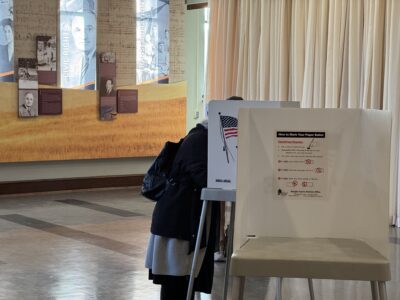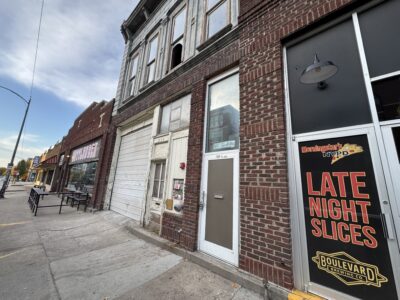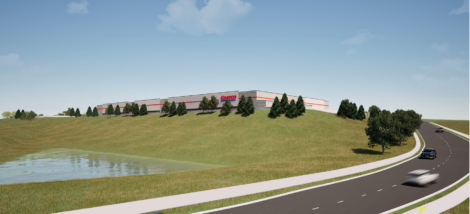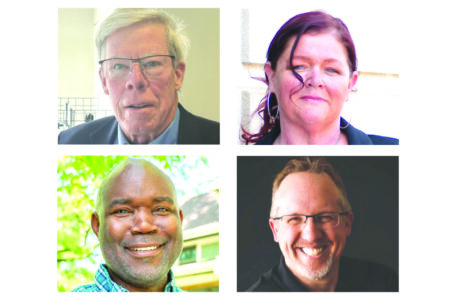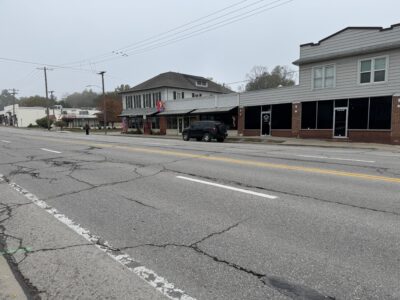
Long at the city’s edge, this old farmhouse property may become site of Lawrence’s newest affordable housing

photo by: Chad Lawhorn/Journal-World
The vacant property at 5275 W. Sixth Street is pictured on Feb. 10, 2025.
There have been many predictions over the last decade that a well-situated farmhouse overlooking growing northwest Lawrence would succumb to development. What there have been fewer predictions of is that the prime piece of real estate would be the home for an affordable housing project.
But indeed that looks like a strong possibility, as plans have been filed for the 3-acre property at 5275 W. Sixth St. to house a 42-unit apartment complex that would be part of an affordable housing program for residents 55 and older.
If you are having a hard time picturing the location, it is the hill just west of Wakarusa Drive. Some would say it is at the southeast corner of Sixth Street and Queens Road, but technically it is at the southeast corner of Sixth Street and Branchwood Drive. For some reason, the old street that is north of Sixth Street is named Queens Road, but the newer street south of Sixth Street is Branchwood.
Whatever the address, an Atlanta nonprofit housing corporation is interested in making the site the city’s next location for affordable housing. Resource Housing Group Inc. is in the process of buying the property to proceed with the apartment project.
If some of this sound familiar, it might be because we reported on the project in March when it went before the city’s Public Incentives Review Committee seeking approval for an exemption on paying sales tax for construction materials related to the project. The group won the exemption, but there hasn’t been any construction taking place at the site.
Instead, the developers were finalizing plans for the project — called the Peaks of Lawrence — and now hope to start construction in mid-April, the project’s architect, Lawrence-based Paul Werner Architects, told me via email. Look for the apartment building to be two stories tall, and include 21 two-bedroom and 21 one-bedroom apartment units.
Plans call for the project to be independent senior living, as opposed to assisted living or a skilled nursing unit, Paul Werner told me. A representative with Resource Housing Group also confirmed to me that the project will include income guidelines for future residents.
Sam Coats, vice president of development for Resource Housing Group, told me via email that the project is part of the federal Low Income Housing Tax Credit program, which means it will be rent-controlled and required to rent to people who meet certain income guidelines.
The project in July was awarded $812,500 in tax credits to help finance the project, according to information from the Kansas Housing Resources Corp., which oversees the federal tax credit program in the state.
In general, most low-income tax credit projects must rent to people who make 80% or less of the median income in the area, and of those renters, 20% of them must make no more than 50% of the area’s median income.
Rent rates are capped based on the tenant’s income. For example, in 2024, people in LITC projects paid no more than $573 per month for a one-bedroom apartment, if they made 30% of the area’s median income and about $1,100 if they made 60% of the median income. The majority of the residents in a tax credit program must make 60% or less of the median income.
As for the developer of the project, Resource Housing Group, Inc. is a large nonprofit. It has developed more than 50 properties across the country with a combined 6,000 living units. According to its website, it has another 500 units in the development stage.
The Lawrence property — which still has the old farmhouse and outbuildings — has been vacant for years. The city has pretty much grown up around the site. I wrote about it all the way back in 2008 when longtime owners Bill and Darlene Naff still lived on the property. The subject of that article was how the couple — who was in their mid-70s, at the time — were worrying that city growth soon would make it impractical for them to keep living on their little piece of the country.

photo by: Chad Lawhorn/Journal-World
A vacant farmhouse property at 5275 W. Sixth Street is pictured on Feb. 10, 2025.
Nobody back then would have guessed it would have taken another 16 years for the property — which is just a half-mile west of Wakarusa Drive — to develop. Certainly, other development plans have been filed for the property over the years, but ultimately those plans never came to fruition.
Think about that for a moment: In a town that has struggled with housing supply, a 3-acre farmstead along one of the most improved streets in the city has sat vacant for more than a decade while the city has grown up around it.
The property is probably a good Rorschach test on your views of development. For some, the scene is viewed as a frustration, for others a victory. Soon enough, it all may be moot.


